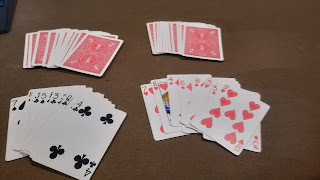My favorite magic tricks are those that require no sleight of hand. Many tricks use math to complete the trick. This trick and others outlined by this blog also use math.
Set-up
Use a standard 52-card deck of cards. Shuffle the deck and
allow your guest to shuffle the deck. Demonstrate to your guest what you want
them to do.
Deal the first card face up on the table. If the card is red
(hearts or diamonds), place the card face up on the right or if it is black
(spades or clubs), place the card face up on the left. Deal the second card
face down in a new pile directly above where you placed the first card. Repeat
this a few times until your guest understands the process. Your guest can continue
with this process or offer them to re-shuffle and start from the beginning of
the deck.
Your guest continues with this process until all 52 cards
have been dealt. There will be two face up piles of red cards (on the right)
and black cards (on the left) and two face down piles above the two face up piles.
Next, ask your guest and other people present if they think
there are more red cards in the face down pile on the right than black face
down cards on the left. Remind your guests that cards dealt face down in either
pile are independent of the card dealt prior face up. Your guests may have
noticed a discrepancy in the number of red and black cards dealt up. This is
common and encourage the discussion of how this might impact the number of red
and black cards in the face down piles.
Complete the trick
Announce to your group that you project the number of red
cards in the right face down pile is the same as the number of black cards in
the left face down pile.
Ask your guest to flip over the two piles of face down cards
and count the number of red and black cards in each pile to confirm your
prediction that the number of red cards in the right face down pile matches the
number of black face down cards in the left pile.
Variation
After the deck has been dealt into the four piles, ask another
person in the audience to give a number between one and seven. Have the guest
who was dealing, switch that number of cards from the two face down piles
with each other.
How does this trick work?
After all the cards are dealt out, we have four piles with
two face up piles of red and black cards and two piles of face down cards.
Designate the number of face up red cards as X. There will be
an equal number (X) of face down cards on the right. Designate the number of
red cards in the face down pile as R. Therefore, the number of black cards in
the right face down pile will be X-R.
The number of face up black cards on the left will be 26-X
(this is actually 52 total cards minus 2 times the number of cards dealt on the
right hand side).
There are a total 26 black cards in the deck so the number
of black cards on the left face down side will equal 26 minus the black cards
dealt face up (26-X) and minus the black cards dealt face up in the right pile (X-R).
The final result of the black card dealt face down on the left
hand side (B), will be:
B = 26 – (X-R) – (26 – X) or with the 26 and X canceling,
B = R
Regarding the variation of switching an equal number of
cards in the right and left face down piles, the equation remains the same
because trading the cards in the face down piles doesn’t impact the final
equation of B = 26 – (X-R) – (26 – X).









No comments:
Post a Comment